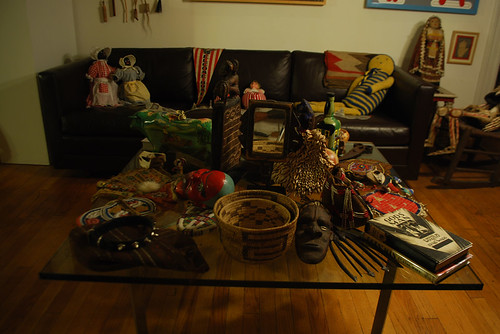Installing the Barcelona Table
Wednesday, March 16th, 2011 » By James Connolly » See more posts from STAFF PICS
I’ve often started tours of the RBSC by gathering a group around the Barcelona table in the living room, using it to introduce the logic behind the formation of Roger Brown’s collection.

Located centrally in the living room of Roger Brown’s former Chicago home, the Barcelona Table and the objects on it reveal the convergence of Brown’s taste with that of his partner, the architect George Veronda. The pinnacle of modern architecture and design, the work of Mies van der Rohe exemplifies simplicity of structure and form, yet finds new life in the obliteration of its spareness by Brown’s installation of transcultural art and everyday objects. What is supposed to be an object of minimal design becomes one art-object among many, a well-designed display for a painted Jack Daniels bottle, a spiked dog collar, African sculptures, a novel in woodcuts by Lynn Ward, among many other things. The lack of hierarchical relationships between objects and the juxtaposition of seemingly incompatible origins relates to Brown’s methodology of collection and arranging, inviting the viewer to form their own themes and correlations through their own interpretations.

With the help of RBSC interns Courtney Bird Ziegler and Danny Augustine I recently deinstalled, cleaned, and reinstalled Roger Brown’s arrangement of objects on the Mies van der Rhoe Barcelona table. Documenting the reinstallation process, we created a series of photographs showing the display in various stages, revealing the process behind Brown’s installation.
The complete set of photographs can be found on our flickr set here.
In the end, the table reveals Roger Brown’s collection to have been developed within the culture of inclusion that has existed within and around the School of the Art Institute of Chicago from Helen Gardner to Whitney Halsted and Ray Yoshida and beyond. Gardner, who started teaching at SAIC in 1920, wrote Art Through the Ages, the first art history textbook to include both Western and Eastern cultures. Whitney Halsted, an art history instructor at SAIC while Brown was a student encouraged his students to explore the galleries of the Field Museum of natural history to be exposed to art from non-Western cultures, while Ray Yoshida, Brown’s painting instructor, pushed students to visit places like the Maxwell Street Market in search of various found objects.
Roger Brown continued and expanded upon these traditions in his own collecting practices, combining cross-cultural artworks and various other objects with works by artists contemporary to him such as Henry Darger, Jesse Howard, Jim Nutt, Aldo Piacenza, Barbara Rossi, Drossos Skyllas, Joseph Yoakum, and Karl Wirsum (among many, many others) in ways that lacked museum-like separations into various categories. Talking about his own methods of collecting and displaying objects in a letter to RBSC curator, Brown referenced the table directly as being emblematic of his curatorial point of view:
I think keeping masses of objects on the Barcelona Table is something that expresses my attitude toward art. Both the table and every little thing on it is aesthetic if not art on its own right. I like breaking the Meisian simplicity of the “horror vacui”⎯though I fully appreciate both very valid attitudes in art.
-James Connolly

